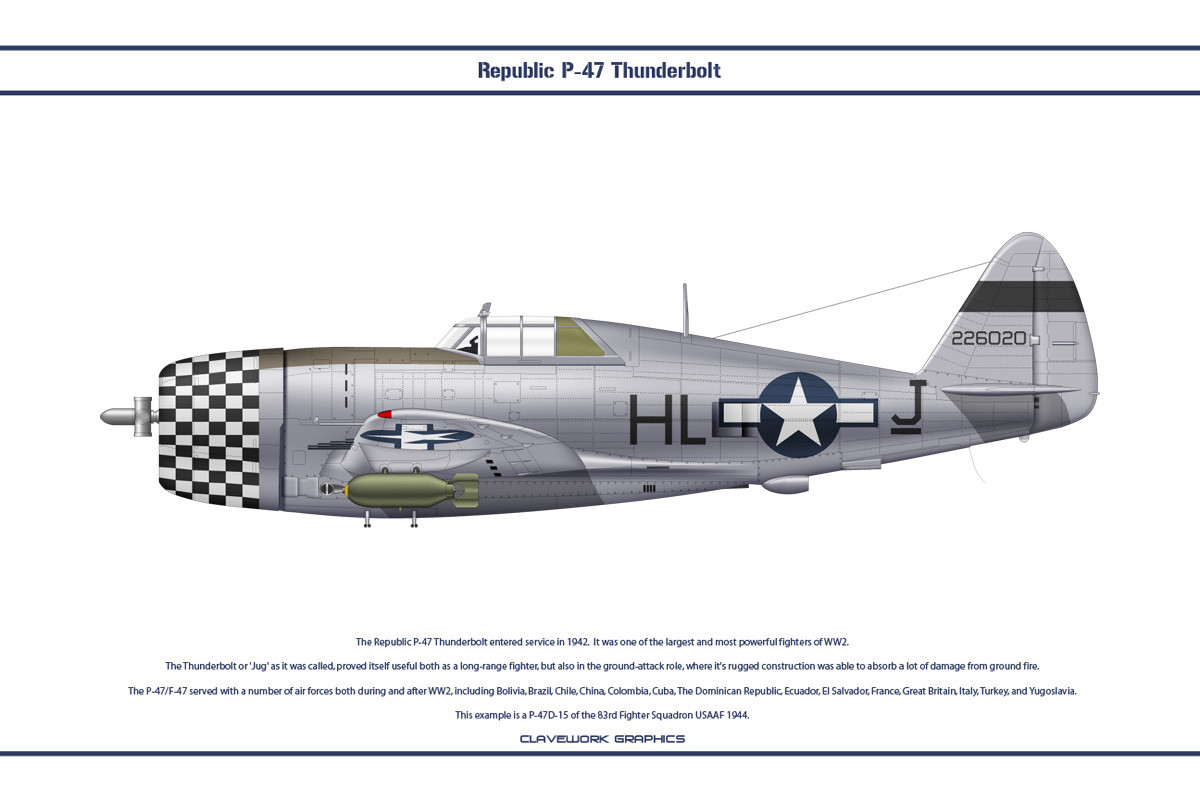HOME | DD
 Claveworks — P-47 USAAF 83rd FS 1
Claveworks — P-47 USAAF 83rd FS 1

Published: 2012-05-25 23:51:15 +0000 UTC; Views: 2965; Favourites: 30; Downloads: 0
Redirect to original
Description
The Republic P-47 Thunderbolt entered service in 1942. It was one of the largest and most powerful fighters of WW2. The design evolved as the war progressed, and the D-25 was the first to feature the bubble type canopy which had proven itself in other aircraft of the time. The canopy was later retrofitted to some of the earlier aircraft. The Thunderbolt or 'Jug' as it was called, proved itself useful both as a long-range fighter, but also in the ground-attack role, where it's rugged construction was able to absorb a lot of damage from ground fire.The P-47/F-47 served with a number of air forces both during and after WW2, including Bolivia, Brazil, Chile, China, Colombia, Cuba, The Dominican Republic, Ecuador, El Salvador, France, Great Britain, Italy, Turkey, and Yugoslavia.
The P-47 was armed with 8 x 12.7mm machine guns, and could carry bombs, rockets, or fuel tanks under the fuselage or wings.
This example is a P-47D-15 of the 83rd Fighter Squadron 1944.
Related content
Comments: 14

Believe it or not I think some were even provided to the USSR with the Northern Fleet. Fantatsic work as always!
👍: 0 ⏩: 1

Yep, some D-10s, and 100 D-22s and D-27s each. The Russians weren't impressed... according to Soviet test pilot Mark Gallai, 'The P-47 Thunderbolt is not a fighter. It is bigger and heavier than our standard frontal bomber (the Pe-2) and it has longer range. It carries more bombs and is more heavily armed.'1 It wasn't a compliment... haha.
1. Soviet Lend-Lease Fighter Aces of World War 2 by George Mellinger (i know, I'm a history major but I really don't care to go through all the 'proper citing' right now).
👍: 0 ⏩: 2

The Russians were very tetchy about a lot of lease-lend aircraft - they liked the Hurricane, but not the Spitfire.... but I am surprised they did not like a rugged beast like the Thunderbolt...
👍: 0 ⏩: 1

They liked the Hurricane because it was at least as good as the LaGG-3 in terms of speed and maneuverability and was very rugged, particularly the landing gear (And it had radios and a windscreen and canopy with clear glass of course!). Hence the Hurricane also mostly saw use in the Northern Fleet and the Kuban. It was also a very easy aircraft to learn to fly with very forgiving flight qualities. The Spitfire on the other hand often got mistaken for Bf 109s by other Soviet pilots and AA gunners, and had very fragile landing gear and wasn't as easy to master. So primarily what the Soviets would use them for was actually as sort of aircraft controllers, like a very rudimentary AWACS. It would fly high above the battlefield and direct other fighters where they needed to be.
For fighters, however, the Soviets theories on fighters were fairly exemplified by the Yak and La-5/7 series. Light, responsive but forgiving and rugged with just enough gun (1/2x mgs and 1x cannon as per the Yak or 2/3x cannon as per the Lavochkin) and good visibility. Which if that is your philosophy on fighters... the P-47 fits none of those categories, haha. Even their beloved Kobrushkas (the P-39) they often would strip the wing-guns out of them (also contrary to popular Western mythology, the Soviets used the P-39 as an air superiority fighter, not a tank buster) and just rely on the single 20/37mm cannon and twin 12.7mm machine guns in the nose. And if you ever see an artwork or something of a P-39 with Soviet markings and the two 12.7mm machine guns in the underwing gondolas... it's a fiction. There is no photographic evidence the Soviets ever got P-39s equipped with them and if they did they would have undoubtedly removed them. Lighter, faster, nimbler, in numbers and low-altitude, that was the Soviet philosophy.
👍: 0 ⏩: 1

Excellent summary!
And thinking about the low-level thing, it makes perfect sense, as they were doing a lot of IL-2 ground attack missions, so fighter cover would need to be nimble.
👍: 0 ⏩: 1

Why thank you, I'm hoping to get into graduate school this fall to be an aviation historian. To say it's a passion would honestly be an understatement, I'm obsessed, haha. Yes, the average combat on the Eastern Front took place under 5,000m, or a little over 16,000 feet. Legend has it (I've never read the actual orders just hearsay) that German pilots were forbidden to dogfight below that altitude with the Yak-3. Hence planes with engines rated for lower altitudes like the P-39 and the P-40 were immensely popular before home-made designs like the Yak series and the La-5/7 came into their own.
Even then, units like the 9th GIAD under Aleksandr Pokryshkin refused to convert from the P-39 to indigenous types until the Cold War started and supplies for the P-39 dried up (Pokryshkin was very skeptical of home-grown Soviet designs particularly after the death of his friend Aleksandr Klubov in a landing accident in an La-7). But primarily, the P-47s put into Soviet service were used as ground-attack planes by the Northern Fleet.
👍: 0 ⏩: 0

Thank you...I'll look for it!
👍: 0 ⏩: 1

It's a good one, very insightful into the Soviet uses of the Hurricane, the Tomahawk/Kittyhawk and the mighty Kobrushka in particular.
👍: 0 ⏩: 1

Indeed, Aircraft of the Aces #74.
👍: 0 ⏩: 1



























